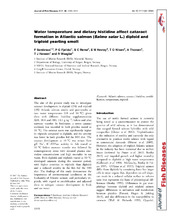| dc.contributor.author | Sambraus, Florian | |
| dc.contributor.author | Fjelldal, Per Gunnar | |
| dc.contributor.author | Remø, Sofie C. | |
| dc.contributor.author | Hevrøy, Ernst Morten | |
| dc.contributor.author | Nilsen, Tom Ole | |
| dc.contributor.author | Thorsen, Anders | |
| dc.contributor.author | Hansen, Tom Johnny | |
| dc.contributor.author | Waagbø, Rune | |
| dc.date.accessioned | 2018-01-05T08:21:56Z | |
| dc.date.available | 2018-01-05T08:21:56Z | |
| dc.date.issued | 2017-09 | |
| dc.Published | Sambraus F, Fjelldal PG, Remø Sc, Hevrøy EM, Nilsen TO, Thorsen A, Hansen TJ, Waagbø R. Water temperature and dietary histidine affect cataract formation in Atlantic salmon (Salmo salar L.) diploid and triploid yearling smolt. Journal of Fish Diseases. 2017;40(9):1195-1212 | eng |
| dc.identifier.issn | 1365-2761 | en_US |
| dc.identifier.issn | 0140-7775 | en_US |
| dc.identifier.uri | https://hdl.handle.net/1956/17135 | |
| dc.description.abstract | The aim of the present study was to investigate cataract development in diploid (2N) and triploid (3N) Atlantic salmon smolts and post-smolts at two water temperatures (10 and 16 °C) given diets with different histidine supplementation (LH, 10.4 and HH, 13.1 g kg−1) before and after seawater transfer. In freshwater, a severe cataract outbreak was recorded in both ploidies reared at 16 °C. The cataract score was significantly higher in triploids compared to diploids, and the severity was lower in both ploidies fed the HH diet. The cataract development at 10 °C was minor. Low gill Na+, K+-ATPase activity in fish reared at 16 °C before seawater transfer was followed by osmoregulatory stress with elevated plasma electrolyte concentrations and high mortality in sea water. Both diploids and triploids reared at 10 °C developed cataracts during the seawater period, with higher severities in triploids than diploids and a reduced severity in the fish fed the HH diet. The findings of this study demonstrate the importance of environmental conditions in the husbandry of Atlantic salmon, and particularly triploids, with regard to smoltification and adjusted diets to mitigate cataract development in fresh and sea water. | en_US |
| dc.language.iso | eng | eng |
| dc.publisher | Wiley | en_US |
| dc.rights | Attribution CC BY | eng |
| dc.rights.uri | http://creativecommons.org/licenses/by/4.0/ | eng |
| dc.subject | Atlantic salmon | eng |
| dc.subject | cataract | eng |
| dc.subject | histidine | eng |
| dc.subject | smoltification | eng |
| dc.subject | Temperature | eng |
| dc.subject | triploid | eng |
| dc.title | Water temperature and dietary histidine affect cataract formation in Atlantic salmon (Salmo salar L.) diploid and triploid yearling smolt | en_US |
| dc.type | Peer reviewed | |
| dc.type | Journal article | |
| dc.date.updated | 2017-11-06T11:37:39Z | |
| dc.description.version | publishedVersion | en_US |
| dc.rights.holder | Copyright 2017 The Author(s) | en_US |
| dc.identifier.doi | https://doi.org/10.1111/jfd.12594 | |
| dc.identifier.cristin | 1463985 | |
| dc.source.journal | Journal of Fish Diseases | |
| dc.relation.project | Norges forskningsråd: 216197 | |
| dc.relation.project | Fiskeri- og havbruksnæringens forskningsfond: 900723 | |

